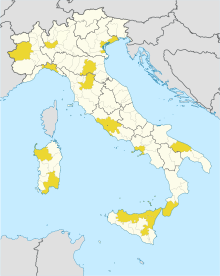The 14 metropolitan cities of Italy (Italian: città metropolitane d'Italia) are administrative divisions of Italy, operative since 2015, which are a special type of province. The metropolitan city, as defined by law, includes a large core city and the surrounding suburbs and countryside closely related to it by economic activities and essential public services, as well as to cultural relations and to territorial features.

History
editThe original 1990 law defined as metropolitan cities the comuni of Turin, Milan, Venice, Genoa, Bologna, Florence, Rome, Bari, Naples and their respective hinterlands, reserving the autonomous regions the right to individuate metropolitan areas in their territory.[1] In 2009, amendments added Reggio Calabria to the list.[2] The metropolitan areas defined by the autonomous regions were: Cagliari and Sassari in Sardinia; Catania, Messina and Palermo in Sicily.
On 3 April 2014 the Italian Parliament approved a law that established ten metropolitan cities in Italy,[3] excluding the autonomous regions. Five more were added later. The new metropolitan cities (except Sassari, which ceased to exist in 2016 after being merged with the province of Olbia-Tempio to form the province of Sassari) have been operative since 1 January 2015.
Government
editA metropolitan city is composed of a central city, which serves as the seat of government, and its surrounding municipalities (comuni). Each metropolitan city is headed by a metropolitan mayor (sindaco metropolitano), who is assisted by a legislative body, the metropolitan council (consiglio metropolitano), and by a non-legislative assembly, the metropolitan conference (conferenza metropolitana).[4]
The metropolitan mayor is the chief executive and administrative officer of the city. The mayor represents, convenes and chairs meetings of the metropolitan council, administers city offices, supervises the functioning of city services, and prepares the city's budget.[4] The mayor of the provincial capital comune automatically becomes the metropolitan mayor.[4]
The metropolitan council is the chief legislative body of the metropolitan city. It proposes laws and amendments to the metropolitan conference, and approves programs, regulations and rules submitted to it by the metropolitan mayor such as the budget.[4] The council consists of mayors and city councillors of each commune in the metropolitan city elected from amongst themselves using partially open list proportional representation, with seats allocated using the D'Hondt method.[4] Metropolitan councillors are elected at-large for five-year terms; votes for metropolitan councillors are weighted by grouping comunes of a certain population range into nine groups so that votes of the mayors and city councillors of the more populous groups are worth than those of less populous groups.[4] The number of councillors a metropolitan city is granted depends upon its population: metropolitan cities with a population of 3 million or more have 24 councillors; metropolitan cities with a population of 800,000 but less than or equal to 3 million have 18 councillors; all other metropolitan cities have 14 councillors.[4]
The metropolitan conference adopts or rejects laws and amendments approved by the metropolitan council. It is the ultimate approving body of the city's budget.[4] Actions in the conference require votes of at least two-thirds of comunes in the metropolitan city and the majority of overall resident population. The conference is composed of all mayors of the communes within the metropolitan city.[4][5]
Functions
editMetropolitan cities carry out the basic functions of a province, principally:[4]
- Local planning and zoning
- Provision of local police services
- Transport and city services coordination
Metropolitan cities
edit| Metropolitan city | Area (km²) | Population (May 2020) |
Population density (/km2) |
Operative since | Mayor |
|---|---|---|---|---|---|
| Rome (Roma) | 5,352 km2 (2,066 sq mi) | 4,323,664 | 811 | 1 January 2015 | Roberto Gualtieri (PD) |
| Milan (Milano) | 1,575 km2 (608 sq mi) | 3,274,499 | 2,064 | 1 January 2015 | Giuseppe Sala (Ind) |
| Naples (Napoli) | 1,171 km2 (452 sq mi) | 3,076,675 | 2,634 | 1 January 2015 | Gaetano Manfredi (Ind) |
| Turin (Torino) | 6,827 km2 (2,636 sq mi) | 2,246,423 | 329 | 1 January 2015 | Stefano Lo Russo (PD) |
| Palermo | 5,009 km2 (1,934 sq mi) | 1,245,826 | 250 | 4 August 2015 | Roberto Lagalla (UDC) |
| Bari | 3,821 km2 (1,475 sq mi) | 1,222,171 | 328 | 1 January 2015 | Vito Leccese (PD) |
| Catania | 3,574 km2 (1,380 sq mi) | 1,101,463 | 310 | 4 August 2015 | Enrico Trantino (FdI) |
| Bologna | 3,702 km2 (1,429 sq mi) | 1,017,225 | 274 | 1 January 2015 | Matteo Lepore (PD) |
| Florence (Firenze) | 3,514 km2 (1,357 sq mi) | 1,000,111 | 288 | 1 January 2015 | Sara Funaro (PD) |
| Venice (Venezia) | 2,462 km2 (951 sq mi) | 849,173 | 347 | 1 January 2015 | Luigi Brugnaro (Ind) |
| Genoa (Genova) | 1,839 km2 (710 sq mi) | 831,786 | 457 | 1 January 2015 | Marco Bucci (Ind) |
| Messina | 3,266 km2 (1,261 sq mi) | 618,459 | 192 | 4 August 2015 | Federico Basile (ScN) |
| Reggio Calabria | 3,183 km2 (1,229 sq mi) | 539,079 | 172 | 31 January 2016 | Giuseppe Falcomatà (PD) |
| Cagliari | 1,248 km2 (482 sq mi) | 429,667 | 345 | 1 January 2017 | Massimo Zedda (PP) |
See also
editReferences
edit- ^ http://www.edscuola.it/archivio/norme/leggi/l142_90.html Law 8 June 1990 n. 142
- ^ "Legge 5 maggio 2009, n. 42" [Law 5 May 2009 n. 42] (PDF). Archived from the original (PDF) on 27 September 2011.
- ^ "Addio alle vecchie Province, è legge il Ddl Delrio. Forza Italia: è un golpe". Il Sole 24 ORE (in Italian). Archived from the original on Oct 16, 2023.
- ^ a b c d e f g h i j "LEGGE 7 aprile 2014, n. 56" (PDF). ponmetro.it/. Pon Metro. Retrieved 13 August 2019.
- ^ "Città metropolitane/I nuovi organi".
External links
edit- Media related to Metropolitan cities of Italy at Wikimedia Commons